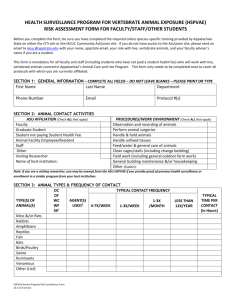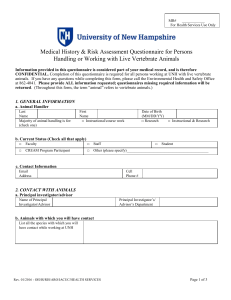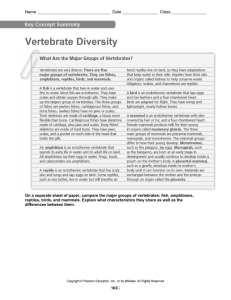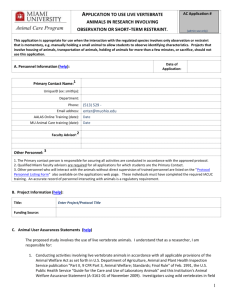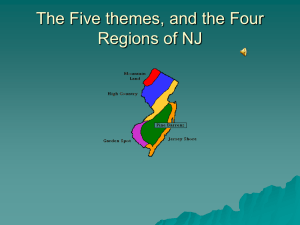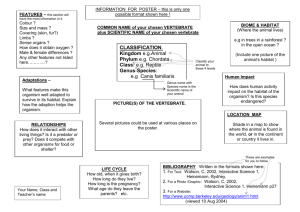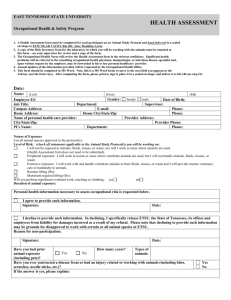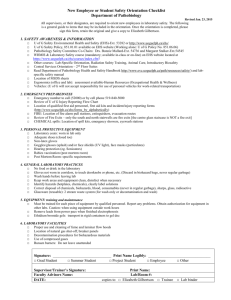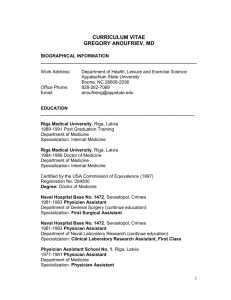OHS Form for Students Updated 7/8/2014 (docx 37.9 KB)
advertisement
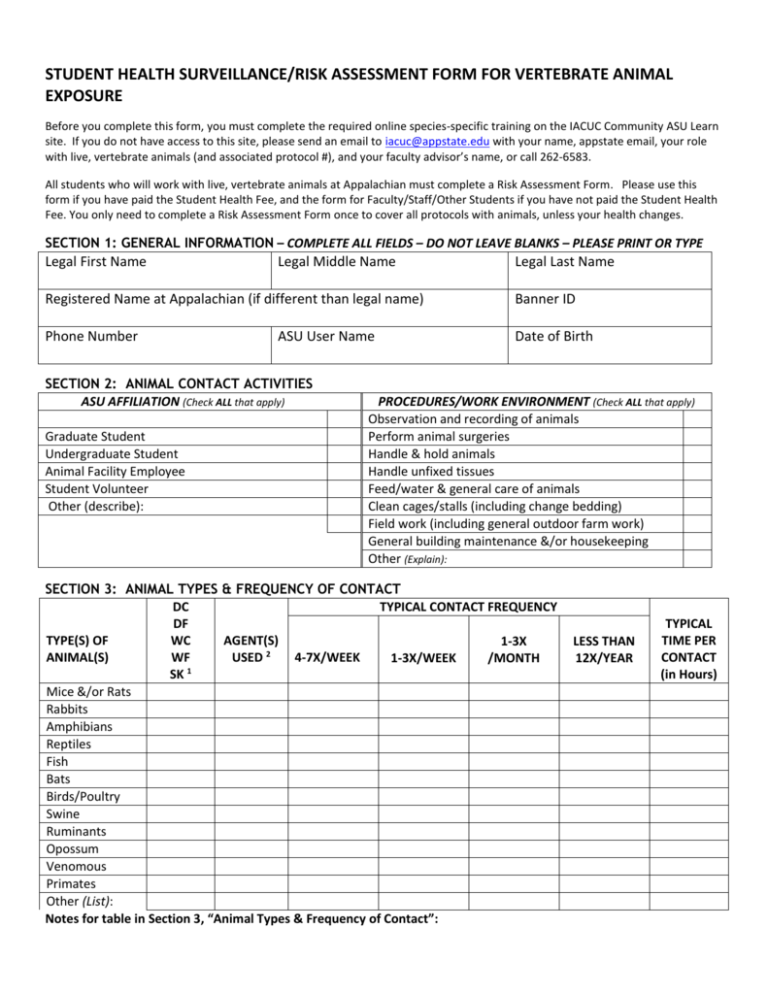
STUDENT HEALTH SURVEILLANCE/RISK ASSESSMENT FORM FOR VERTEBRATE ANIMAL EXPOSURE Before you complete this form, you must complete the required online species-specific training on the IACUC Community ASU Learn site. If you do not have access to this site, please send an email to iacuc@appstate.edu with your name, appstate email, your role with live, vertebrate animals (and associated protocol #), and your faculty advisor’s name, or call 262-6583. All students who will work with live, vertebrate animals at Appalachian must complete a Risk Assessment Form. Please use this form if you have paid the Student Health Fee, and the form for Faculty/Staff/Other Students if you have not paid the Student Health Fee. You only need to complete a Risk Assessment Form once to cover all protocols with animals, unless your health changes. SECTION 1: GENERAL INFORMATION – COMPLETE ALL FIELDS – DO NOT LEAVE BLANKS – PLEASE PRINT OR TYPE Legal First Name Legal Middle Name Legal Last Name Registered Name at Appalachian (if different than legal name) Banner ID Phone Number Date of Birth ASU User Name SECTION 2: ANIMAL CONTACT ACTIVITIES ASU AFFILIATION (Check ALL that apply) Graduate Student Undergraduate Student Animal Facility Employee Student Volunteer Other (describe): PROCEDURES/WORK ENVIRONMENT (Check ALL that apply) Observation and recording of animals Perform animal surgeries Handle & hold animals Handle unfixed tissues Feed/water & general care of animals Clean cages/stalls (including change bedding) Field work (including general outdoor farm work) General building maintenance &/or housekeeping Other (Explain): SECTION 3: ANIMAL TYPES & FREQUENCY OF CONTACT DC TYPICAL CONTACT FREQUENCY DF TYPE(S) OF WC AGENT(S) 1-3X ANIMAL(S) WF USED 2 4-7X/WEEK 1-3X/WEEK /MONTH SK 1 Mice &/or Rats Rabbits Amphibians Reptiles Fish Bats Birds/Poultry Swine Ruminants Opossum Venomous Primates Other (List): Notes for table in Section 3, “Animal Types & Frequency of Contact”: LESS THAN 12X/YEAR TYPICAL TIME PER CONTACT (in Hours) Legal Last Name Legal First Name Banner ID Indicate the applicable conditions under which your contact with the animals occurs: DC = Domestic and Caged or fenced-In DF = Domestic and Free-range in natural habitat (no cage or fencing) WC = Wild animal but Caged or Fenced-In WF = Wild animal, Free-range in natural habitat SK = Sick animals 2 Indicate any infectious, radiological, or chemical agents to which the animals you handle are intentionally exposed or known to be carrying. Include short-acting anesthetics (e.g. MS-222, Isoflurane) only if you will be handling the anesthetic yourself, or handling the animal while anaesthetized. SECTION 4: HEALTH HISTORY All details of any visit to Student Health Services are confidential. 4.1. Allergy Symptoms: Do you experience any of these symptoms when you work with or are exposed to animals? Have you ever been diagnosed or otherwise identified as having any of the following conditions? Symptoms Yes No Symptoms Watery, burning, itchy eye(s) Coughing Nasal drip Chest tightness Sneezing Rash Wheezing Hives Shortness of breath Other/Describe: Condition Yes No Condition Asthma Positive allergy skin test Allergic rhinitis Latex product allergy Allergic conjunctivitis Family history of asthma or allergy Hay fever Heart valve disease or defect Animal allergy (any kind) Other/Describe: Yes No Yes No 4.2. Symptom Exacerbation: If you marked “yes” to any of the above symptoms or diagnosed conditions, are they made worse when handling the designated research animals or entering the animal research area? □ Yes □ No □ Don’t know □ Choose not to answer 4.3. Other Health Conditions: Do you have, or anticipate having, any condition that the occupational healthcare provider should be made aware of that could affect your ability to perform your research duties without risk of illness or harm? Examples of such conditions include, but are not limited to: pregnancy, asthma, COPD, organ transplant, cancer treatment, cystic fibrosis, type 1 diabetes, lupus, HIV infection, or immunosuppression (natural or medicine-induced). □ Yes □ No □ Don’t know □ Choose not to answer 4.4. Other Concerns: Do you have any health or workplace concerns not covered by this questionnaire that you would like to discuss confidentially with Student Health Services? □ Yes □ No □ Don’t know □ Choose not to answer SECTION 5: IMMUNIZATIONS AND SCREENINGS Tetanus immunization is highly recommended for all individuals with animal contact. A booster shot is needed if it has been 10 or more years since the previous tetanus immunizations. 2 Animal Program Risk Surveillance Form 7.8.14 version Legal Last Name Legal First Name Banner ID Students who work with human or primate blood, unfixed tissues cell lines or stock; or any material subject to the OHSA Bloodborne Pathogens Standard may be enrolled in the University’s Exposure Control Program at recommendation of SHS. Rabies immunization or proof of titer is recommended for individuals who work with ferrets or may be exposed to bats, canines, raccoons, opossums, or squirrels. Please Indicate Your Vaccination Status: Have you had the tetanus vaccine? List date of last tetanus vaccine. Have you had a rabies vaccine? List date of last rabies vaccine. Month: ________/year: ________ Month: ________ /year: ________ Titer date/result: _______________________________ 5.1. OTHER Please list any additional information that you think could be useful in this health risk assessment: __________________________________________________________________________________________________ __________________________________________________________________________________________________ __________________________________________________________________________________________________ SECTION 6: NEXT STEPS 6.1. Sign below and send completed/signed form to: iacuc@appstate.edu 6.2. Research Protections will send forms to Student Health Services (SHS) for review. SHS will share their recommendations, which may include, additional training, follow up, or additional evaluations, with Environmental Health Safety & Emergency Management (EHS & EM). EHS & EM will notify you of any recommendations. It is your responsibility to follow their recommendations. 6.3. If your health changes, you should complete another health risk assessment and follow up with SHS or your personal health care provider, as needed. 6.4. Appalachian’s Environmental Health, Safety & Emergency Management office will keep copies of your completed clearance form, and any required training records. By signing below, I give permission to the Office of Research Protections, EHS & EM office, and Student Health Services, to confidentially maintain a copy of this signed form. I understand if my health status changes while working with live, vertebrate animals at Appalachian State University, that I will need another health risk assessment. ________________________________ Printed name _________________________________ Signature ____________________ Date 3 Animal Program Risk Surveillance Form 7.8.14 version Legal Last Name Legal First Name Banner ID *****This Section to be Completed by Student Health Services***** I have reviewed ________________________________________________________’s HEALTH (name of student) SURVEILLANCE/RISK ASSESSMENT FORM FOR VERTEBRATE ANIMAL EXPOSURE, and determined the following: ___ Individual is cleared for working with animals listed on this form ___ Individual requires airborne allergen mitigation (please circle: PPE, N95 mask/respirator) ___ Individual requires specific training: _________________________________ (list) ___ Individual requires vaccinations: _____________________________________ (list) ____ Individual requires booster (circle: rabies / tetanus) on or before: _________________________ ___ Individual requires an in-person visit for further assessment ___ Other: _________________________________________________________ (list) By signing below, I confirm that I have reviewed this form and made recommendations. This does not constitute a legal attestation that the individual listed above is without risk of exposure to vertebrate animals. _______________________________________________________________ (signature and title) ________________________ (date) Please complete this page and send the signed original to: Appalachian State University’s Environmental Health and Safety & Emergency Management Office, 262-6120 Intercampus mail address: Debi Trivette, EHS&EM, Bldg Svcs Annex. U.S. Postal address: Debi Trivette, ASU EHS&EM Office, ASU Box 32114, 1030 State Farm Rd, Boone NC 28608-2114 Follow Up Section (if applicable) Follow up review comments: By signing below, I confirm that I have reviewed this form and the concerns noted above have been addressed. This does not constitute a legal attestation that the individual listed above is without risk of exposure to vertebrate animals. _______________________________________________________________ (signature and title) ________________________ (date) 4 Animal Program Risk Surveillance Form 7.8.14 version
